Easy Pad Thai
- By Jennifer Segal
- Updated July 15, 2025
- 170 Comments
- Leave a Review

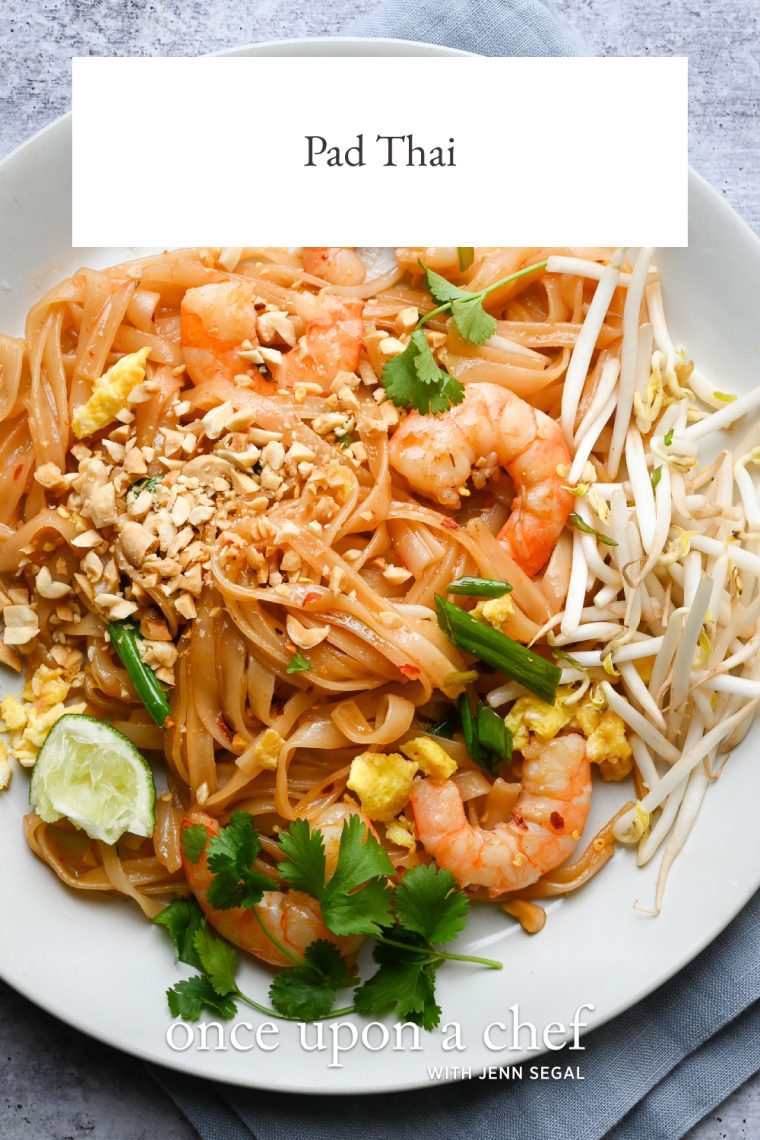
This post may contain affiliate links. Read my full disclosure policy.
Made with pantry staples and easy-to-find ingredients, this pad Thai recipe is weeknight-friendly, full of flavor, and better than takeout.
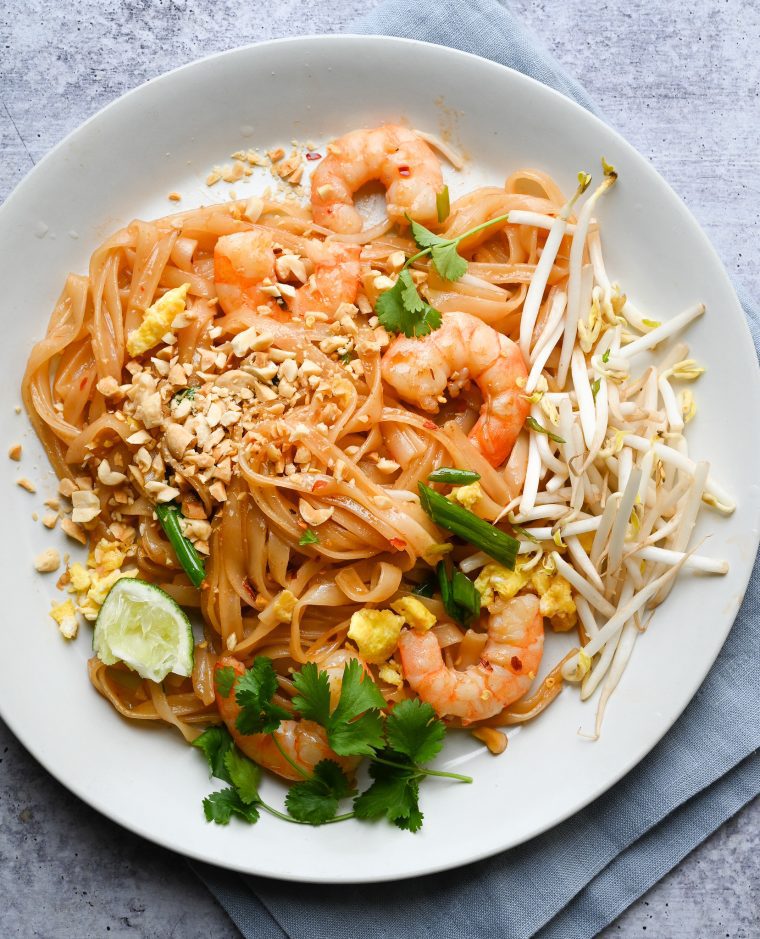
Pad Thai is a quick and flavorful stir-fried noodle dish—a beloved street food in Thailand and a go-to favorite in Thai restaurants around the world. If you love it as much as I do, you’ll be happy to know it’s easier to make at home than you might think!
Traditional pad Thai typically has a daunting list of ingredients—think tamarind liquid, dried shrimp, pickled white radishes, and garlic chives—that can be hard to find at your local grocery store. This simplified, “Westernized” version uses a few smart swaps (yes, that’s why there’s ketchup!) to keep things accessible while still delivering bold, satisfying flavor.
“Made it last night and it is the best pad Thai ever! Easy to make and customize. Thank you!”
Video Tutorial
What You’ll Need To Make Pad Thai
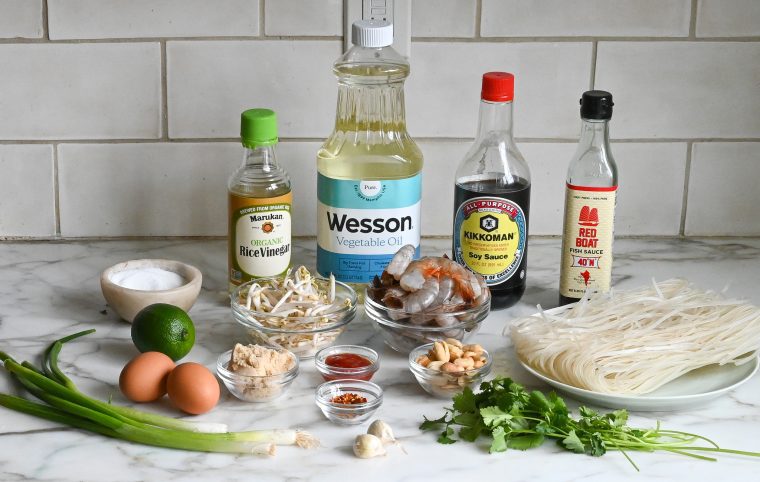
- Flat rice noodles – The key ingredient in pad Thai. You’ll soak them in hot water (not boil) until just tender, then rinse to keep them from turning gummy in the pan. Look for them in the Asian section of most large supermarkets.
- Eggs – Stirred into the noodles for richness and a little extra protein.
- Shrimp (or chicken or tofu) – Shrimp cooks quickly and adds great flavor, but you can easily swap in chicken or tofu. Just slice it thin and cook it through before tossing everything together.
- Garlic and scallions – Sautéed at the start to build the base flavor of the dish.
- Fish sauce and soy sauce – These give the pad Thai its salty, savory backbone. Look for a brand of fish sauce from Thailand or Vietnam, and don’t worry about buying a large bottle—it keeps forever.
- Rice vinegar, ketchup, and light brown sugar – These three balance each other out and create a pantry-friendly version of classic pad Thai sauce. The ketchup stands in for tamarind, adding just enough tang and sweetness.
- Peanuts, bean sprouts, and cilantro – Scattered over the top just before serving. The peanuts add crunch and nuttiness, the bean sprouts bring a fresh, crisp finish, and the cilantro adds a bright, herbal note that ties everything together.
- Jump to the printable recipe for precise measurements
Step-by-Step Instructions
Step 1: Soften the noodles. Bring a large pot of water to a boil, then turn off the heat. Add the noodles, swish to separate, and let sit for 5 to 10 minutes, until soft but still a bit chewy. Drain, rinse with cold water, and set aside. Be careful not to over-soak the noodles—they’ll continue cooking in the pan later. Aim for just shy of al dente so they hold their texture in the finished dish.

Step 2: Beat the eggs. In a small bowl, lightly beat the eggs with a pinch of salt and set aside.
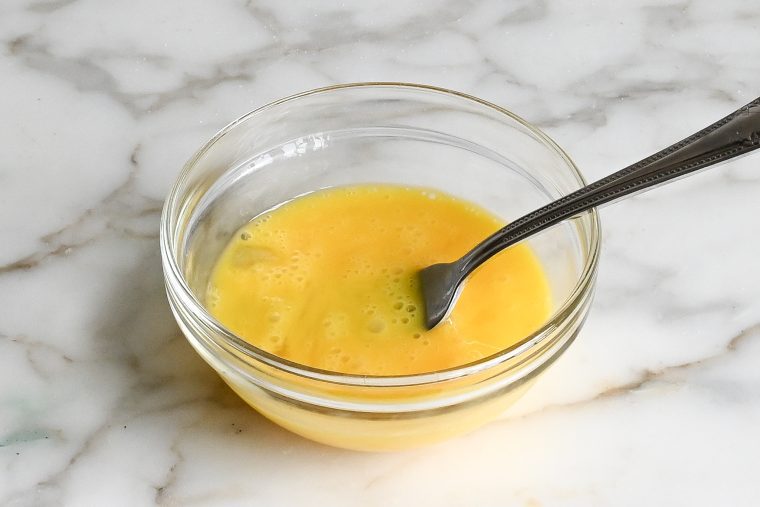
Step 3: Make the sauce. In a medium bowl, whisk together the water, fish sauce, soy sauce, vinegar, ketchup, sugar, and red pepper flakes.
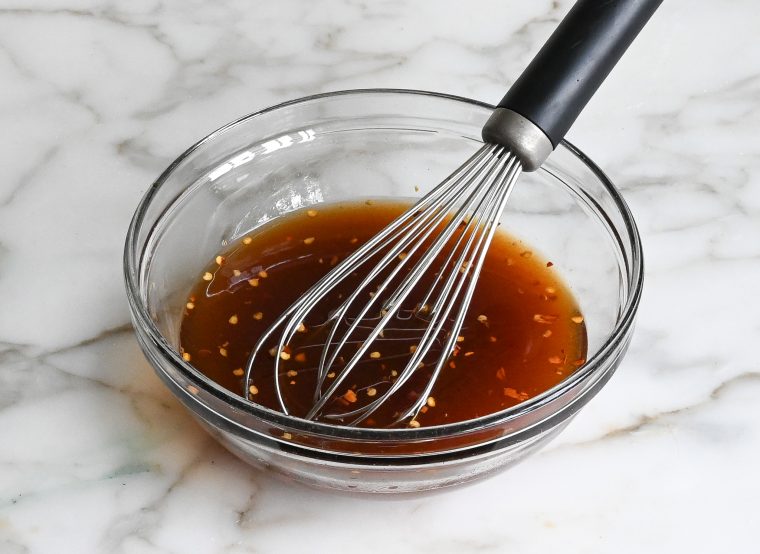
Step 4: Cook the shrimp. Heat 2 tablespoons of oil in a large nonstick pan or wok over medium-high heat. Add the shrimp and a pinch of salt and cook for about 2 minutes, stirring often. Toss in the garlic and light scallion parts and cook 1 minute more. Transfer everything to a plate and scrape the pan clean.
Pro Tip: To avoid overcooking the shrimp, use visual cues; pull them from the heat as soon as they curl into a “C” shape. This will keep them nice and juicy.
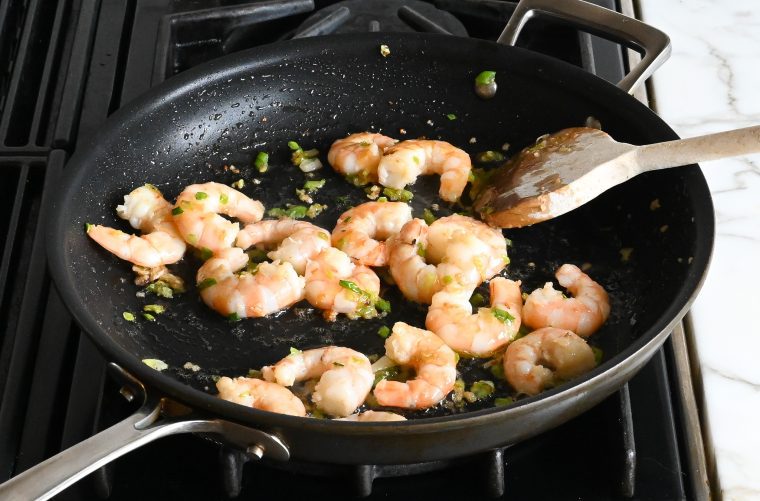
Step 5: Scramble the eggs. Add 1 teaspoon of oil to the pan and scramble the eggs until just cooked through, 1 to 2 minutes. Transfer to the plate with the shrimp.
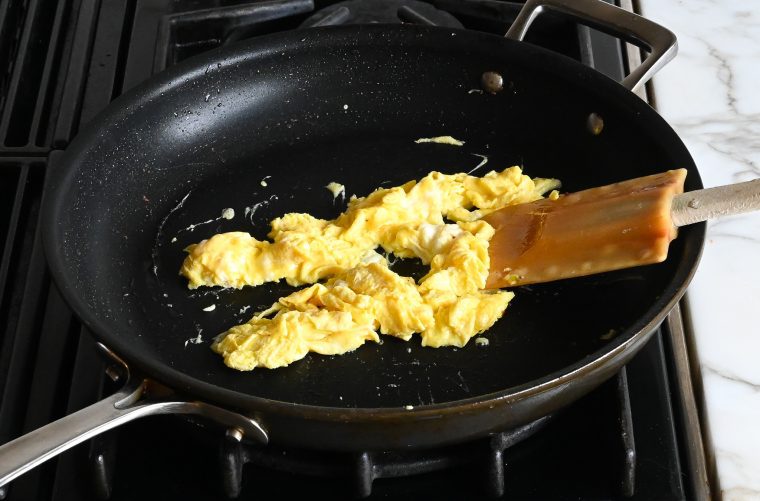
Step 6: Cook the noodles. Add 2 more tablespoons of oil to the pan, then the noodles and sauce. Cook, stirring gently, until the noodles absorb the sauce and are tender. (Use a light hand—tossing too aggressively can break them apart.) If they’re still firm, add a splash of water.
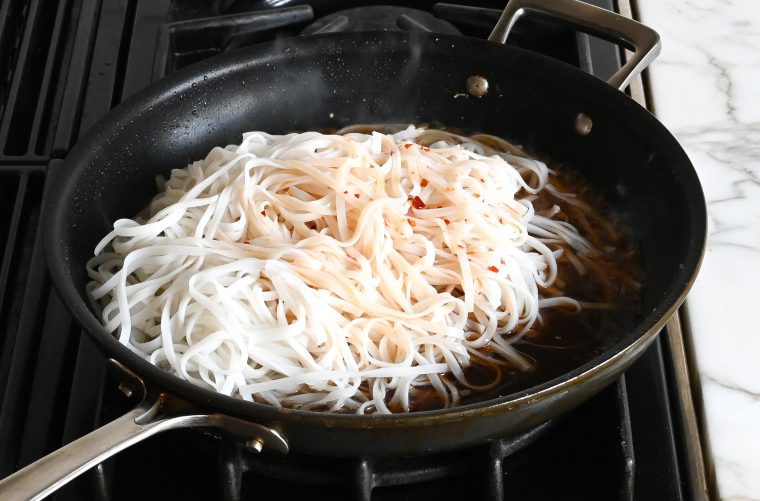
Step 7: Toss and serve. Return the contents of the plate and the dark green scallions to the pan and toss to combine. Serve topped with peanuts, bean sprouts, cilantro, and lime wedges, if desired, and enjoy!
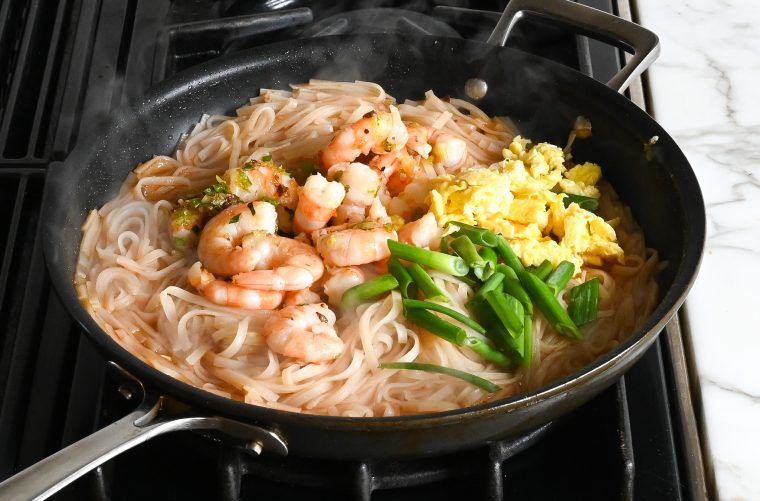
More Asian-Inspired Dishes You’ll Love
Pad Thai

This pad Thai has everything you love, from tender noodles to crisp toppings and a crave-worthy sauce.
Ingredients
- 8 ounces flat rice noodles (linguini or fettuccini width)
- 2 large eggs, beaten
- ¼ cup + 2 tablespoons water
- 2½ tablespoons fish sauce
- 1 tablespoon soy sauce
- 1 tablespoon rice vinegar
- 1½ tablespoons ketchup
- ¼ cup (packed) light brown sugar
- Heaping ¼ teaspoon crushed red pepper flakes
- 4 tablespoons + 1 teaspoon vegetable oil, divided
- ¾ pound large (31/35) shrimp, peeled and deveined, thawed if frozen
- Salt
- 2 cloves garlic, minced
- 3 scallions, light parts thinly sliced, dark green parts cut into 1-inch pieces
- ¼ cup dry roasted salted peanuts, coarsely chopped
- 1 cup bean sprouts
- ¼ cup chopped fresh cilantro (optional)
- Lime wedges, for serving (optional)
Instructions
- Bring a large pot or wide skillet of water to a boil. Off the heat, add the noodles. Briefly swish them around to separate them, then let sit, stirring occasionally to prevent sticking, until the noodles are soft and pliable but still chewy to the bite, 5 to 10 minutes. Drain and rinse well with cold water. Set aside.
- In a small bowl, beat the eggs with a pinch of salt. Set aside.
- Make the sauce: In a medium bowl, whisk together the water, fish sauce, soy sauce, vinegar, ketchup, sugar, and red pepper flakes. Set aside.
- Heat 2 tablespoons of the oil in a large nonstick pan or wok over medium-high heat. Add the shrimp and season with ⅛ teaspoon salt. Cook, stirring often, for two minutes. Add the garlic and light green scallions and cook, stirring constantly, until softened and the shrimp are cooked through, about 1 minute more. Transfer the shrimp, garlic, and scallions to a large plate, using a rubber spatula to scrape the pan clean.
- Add 1 teaspoon of oil to the hot pan. Add the eggs and scramble until cooked through, 1 to 2 minutes. Add to the plate with the shrimp.
- Add 2 tablespoons of the oil to the hot pan. Add the drained noodles to the pan, along with the sauce mixture. Cook, tossing the noodles gently so as not to break them, until the liquid is absorbed by the noodles and the noodles are cooked through, a few minutes. If the noodles are still firm to the bite when the sauce is absorbed, add a few tablespoons of water and continue cooking. Add the contents of the plate and the dark green scallions to the noodles and toss gently to combine, until everything is warmed through. Taste and adjust seasoning if necessary. Transfer to a serving platter and top with peanuts, bean sprouts, and cilantro (if using). Serve with lime wedges, if desired.
Nutrition Information
Powered by ![]()
- Per serving (4 servings)
- Calories: 579
- Fat: 23 g
- Saturated fat: 3 g
- Carbohydrates: 66 g
- Sugar: 17 g
- Fiber: 3 g
- Protein: 28 g
- Sodium: 1,411 mg
- Cholesterol: 230 mg
This website is written and produced for informational purposes only. I am not a certified nutritionist and the nutritional data on this site has not been evaluated or approved by a nutritionist or the Food and Drug Administration. Nutritional information is offered as a courtesy and should not be construed as a guarantee. The data is calculated through an online nutritional calculator, Edamam.com. Although I do my best to provide accurate nutritional information, these figures should be considered estimates only. Varying factors such as product types or brands purchased, natural fluctuations in fresh produce, and the way ingredients are processed change the effective nutritional information in any given recipe. Furthermore, different online calculators provide different results depending on their own nutrition fact sources and algorithms. To obtain the most accurate nutritional information in a given recipe, you should calculate the nutritional information with the actual ingredients used in your recipe, using your preferred nutrition calculator.
Gluten-Free Adaptable Note
To the best of my knowledge, all of the ingredients used in this recipe are gluten-free or widely available in gluten-free versions. There is hidden gluten in many foods; if you're following a gluten-free diet or cooking for someone with gluten allergies, always read the labels of your ingredients to verify that they are gluten-free.
See more recipes:
Comments
Add a Comment Cancel reply
This site uses Akismet to reduce spam. Learn how your comment data is processed.
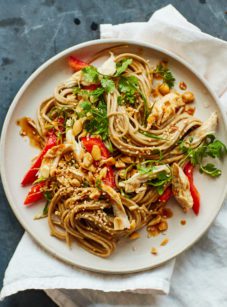

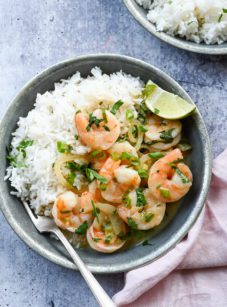

My husband and I both really liked your take on the recipe. I made it with chicken tenders because we had them on hand and added 1 T red Thai paste to the sauce per another reviewer’s suggestion. We like spicy! Another great recipe. Thanks so much.
This is the easiest and most delicious Pad Thai recipe. I love that the ingredients are simple and easily accessible at my local grocery store.
Jenn – you never disappoint. Very authentic with bright flavors. Reduced fish sauce to 2 Tablespoons and it was perfect. We bought Annie Chun’s Thai noodles at WF and put in boiling water for 6 minutes finished by a cold bath. Perfection. Thank you.
Love this pad thai recipe. It comes very close to the pad thai I usually get at my favourite Asian restaurant. I substituted shrimp for chicken, and it still came out great.
I love this website, every recipe is a hit with my family! For me, the noodles turned out perfectly and the taste was delicious. I didn’t expect purely “authentic” thai food and felt highly satisified with this version.
This is, by far, the best pad thai recipe I have ever made. The only thing I did differently was prepare the noodles toward the end, as there is a lot of prep work, and I was worried that they would get overcooked. My family really loved it.
This recipe would need a sodium warning, having over a day’s recommended level. How would cut the level by 2/3s?
Hi Tom, Yes, this recipe is definitely high in sodium. You could reduce it a bit by replacing the fish sauce with additional soy sauce (and using the reduced-sodium variety of soy sauce). Without the fish sauce, this dish will not have the same authentic Thai flavor, but it will still be good. You could also use unsalted nuts on top of the dish. I’m not certain how much these changes reduce the sodium, but it should definitely help.
I tried this recipe again and it was still enjoyable but next time one thing I would do differently towards the end is pour the sauce over all the ingredients, not just the noodles, to better distribute the sauce and to try and avoid “over-saucing” the noodles at the top (is that a word?). Also, this is a “note to self” but I would also try not to overcook the noodles…I find that after adding the noodles to the hot water, I tend to neglect them as I work on prepping all the other ingredients and I don’t like the noodles as much when they are super-soft. That is probably why you recommend actually following cooking times and rinsing the noodles with cold water once they are done…smart advice. 🙂
I’ve tried several Pad Thai recipes and this one is my new favourite. I’ll definitely make it again.
Thanks, Jenn!
This is one of the best Pad Thai I’ve tasted. I added Thai red curry as suggested. It was easy and so tasty. Thank you Jenn.
I made this last night, and my family and I loved it! I followed most of the measurements, and it turned out great. I have always been told that recipes are merely guidelines, and you have to adjust to your liking. I didn’t have to make a lot of adjustments to this one. Thanks for another great recipe!